New Residential Permit Trends in Southern Indiana
Four counties (Clark, Floyd, Harrison and Washington) of southern Indiana belong to the Louisville Metropolitan Statistical Area (metro). Trends in new housing permits are analyzed in the following article for southern Indiana's metro counties and compared to regional and state data for July 2006, but supplemented with more recent August data. In addition, both short and long term trends are discussed.
Southern Indiana Metro Counties
Based on new residential housing permits issued from January to July, the new construction market in southern Indiana fared better than state and regional trends. Table 1 shows housing permit change by geographic region from January to July for 2005 and 2006. The four southern Indiana metro counties saw a slight decline (‑4.9 percent) in housing permits the first seven months of the year. This compares to a 17 percent drop for Indiana and a 38 percent drop for the Louisville metro. Removing the four Indiana counties that comprise the Louisville metro, Louisville and the surrounding Kentucky counties experienced a 46 percent decline in new residential permits.
Table 1: Percent Change in Housing Permits by Geographic Region, January through July, 2005 to 2006
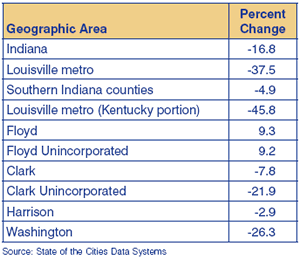
Floyd County housing permits were actually above state and regional trends (see Table 1). However, the numbers are somewhat deceiving. Even though permits increased 9 percent in Floyd County, January saw an unusually high number of issued permits. Housing permits in January were about double typical January levels. As a result, the first quarter for Floyd County was very strong, compared to last year's first quarter. Unlike Floyd County, the other three Indiana counties experienced declines in issued permits. Clark and Washington counties saw the largest declines. Clark county permits were down 8 percent from July 2005 to July 2006, and Washington County actually observed the steepest percentage decline at 26 percent. Harrison County saw the smallest decline in July at only 3 percent.
Figure 1 displays the housing permit changes from 2005 to 2006 for January to August. Since the beginning of 2006, southern Indiana counties performed better than Indiana and the Louisville metro in most of the months. However, the declines in May, July and August for southern Indiana were steeper than in the United States, Indiana and the Louisville metro.
Figure 1: Change in Permits from Previous Year, 2005 to 2006
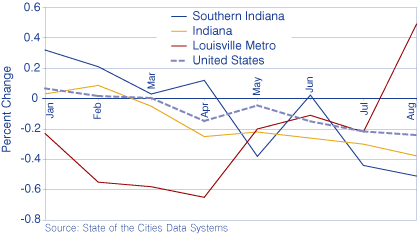
This large decline for July permits in southern Indiana is evident in the August data. Table 2 provides housing permit change by geographic region from January to August for 2005 and 2006. The new August data point to a larger decline in southern Indiana, and a slight improvement in the overall decline for the Louisville metro. August data indicate that southern Indiana permits are down 13 percent the first eight months of 2005 compared to the first eight months of 2006. Floyd County continues to show an increase in permits from August 2005 to August 2006. Trends observed in July for Clark, Washington and Harrison counties continued in August. The recently released August data on new residential permits point to further declines in all three counties. Clark County experienced a larger decline than indicated in July. The August 2005 to August 2006 permit change now shows a decline of 18 percent in Clark County. Harrison likewise experienced much steeper declines in permits.
Table 2: Percent Change in Housing Permits by Geographic Region, January through August, 2005 to 2006

The decline in housing permits for the four counties in southern Indiana corresponds to an approximate $22 million (or 11 percent) reduction in construction dollars compared to August of last year (see Table 3). Clark County leads the way with an aggregate dollar decline of $25 million (or 22 percent). Consistent with the increase in permits for Floyd County, construction dollars are up approximately $6 million (or 11 percent).
Table 3: Construction Investment

Louisville Metro
August data indicate that the Louisville metro improved slightly from July to August, but continued to observe declines larger than the nation and Indiana (see Table 2). Permits point to an 8.7 percent decline in the nation between January–August 2005 and January–August 2006, but a decline of 31 percent in the Louisville metro and 20 percent in Indiana. Removing the four southern Indiana counties from the Louisville metro shows permits are down 37 percent. This is a slight improvement from January–July 2005 to January–July 2006 numbers, which were down 46 percent on the Kentucky side of the Louisville metro (see Table 1).
Incorporated vs. Unincorporated Areas
Clark and Floyd, the two counties with the largest incorporated areas, experienced different patterns with respect to permits issued in incorporated vs. unincorporated areas. For Floyd County, the January–July permits are up 9 percent in the unincorporated sections, but down in the incorporated areas of the county (see Table 1). The decline in permits in incorporated sections of the county can be attributed primarily to New Albany. New Albany permits are down 28 percent when compared to July of 2005 (see Table 4). The largest increase in permits for the first seven months of the year occurred in Georgetown, which is consistent with population trends. Based on a recent analysis of the Indiana Business Research Center, Georgetown has one of the fastest growing populations in Indiana.
Table 4: Changes for Selected Municipalities, January to July, 2005 to 2006
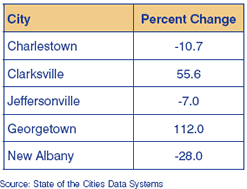
A different trend can be observed in Clark County. Clark County observed a smaller decline in housing permits for incorporated sections of the county. Even though overall permits in the county are down by 8 percent, permits in unincorporated sections of the county are down 22 percent compared to July of last year. The decline in permits in incorporated sections of Clark County can be attributed primarily to Charlestown, where permits were down 11 percent when compared to July 2005 (see Table 4).
Southern Indiana Share of Louisville Metro
Floyd and Clark counties continue to be dominant in the issuance of new residential permits, and unincorporated sections of those two counties lead the way. Figure 2 presents permits by county. Eighty-two percent of permits issued in the four-county region are located in Floyd and Clark counties. Unincorporated sections of those two counties also make up a significant component of overall permits issued, as 55 percent of all permits issued in the four-county area are located in the unincorporated sections of Floyd and Clark. This is up from 43 percent during the year 2000.
Figure 2: Permits by County, 2005
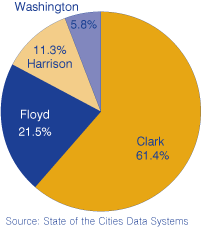
Today, permits in the four southern Indiana counties make up a larger portion of permits generated in the Louisville metro area (see Figure 3). In 2000, southern Indiana counties generated approximately 24 percent of all permits issued in the Louisville metro. By the end of 2005, that number was up to roughly 28 percent (see Figure 4). Currently, southern Indiana is on pace to produce 30 percent of permits generated in the Louisville metro for 2006.
Figure 3: Kentucky and Indiana Share of Louisville Metro Permits
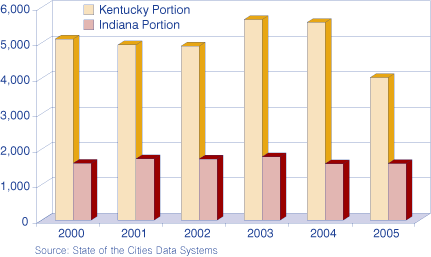
Figure 4: Indiana–Kentucky Share of Permits, 2000 and 2005
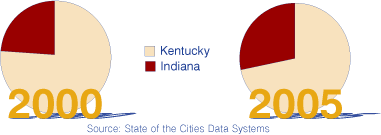
Long Term Trends
Table 5 shows year-end permit changes from 2000 to 2005 for different areas. Over the long term, Indiana has an average decrease of 0.3 percent each year, and the Louisville metro has an average decrease of 2.7 percent each year. As for the southern Indiana counties, Floyd has an average decrease of 2.1 percent each year, Clark has an average increase of 1.2 percent, and Harrison has an average decrease of 8 percent. Overall, within the Louisville metro, the performance of Indiana counties is better than that of the Kentucky counties.
Table 5: Year-End Percent Change in New Construction Permits
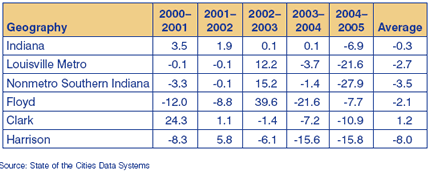
Table 6 shows year-end permit changes from 2000 to 2005 for selected municipalities. Charlestown, Clarksville and Georgetown had very high average increases each year over the long term, while Jeffersonville had a moderate average increase and New Albany had an average decrease.
Table 6: Percent Change in Housing Permits in Selected Municipalities
Summary
In 2006, the new construction market in southern Indiana, as measured by new residential permits, has not observed the declines observed in Louisville, Indiana, and the nation. August data, however, do show a larger decline for southern Indiana, and this decline is larger than the national average for January–August numbers. Clark and Floyd continue to be the dominant counties in terms of total permits issued, and a larger percentage of permits issued in the Louisville metro originate from the four southern Indiana metro counties. The recently released August data on new residential permits point to larger declines in Clark, Washington and Harrison counties. August data also show continued increases in Floyd County. A slight improvement in the Louisville metro from July to August 2006 is also evident. In the long term, however, both southern Indiana and the Louisville metro have a decreasing trend in the number of new permits, but the performance on the Indiana side is better than that on the Kentucky side.
Uric B. Dufrene, Sanders Chair in Business and
Yan He, Associate Professor of Finance
School of Business, Indiana University Southeast

